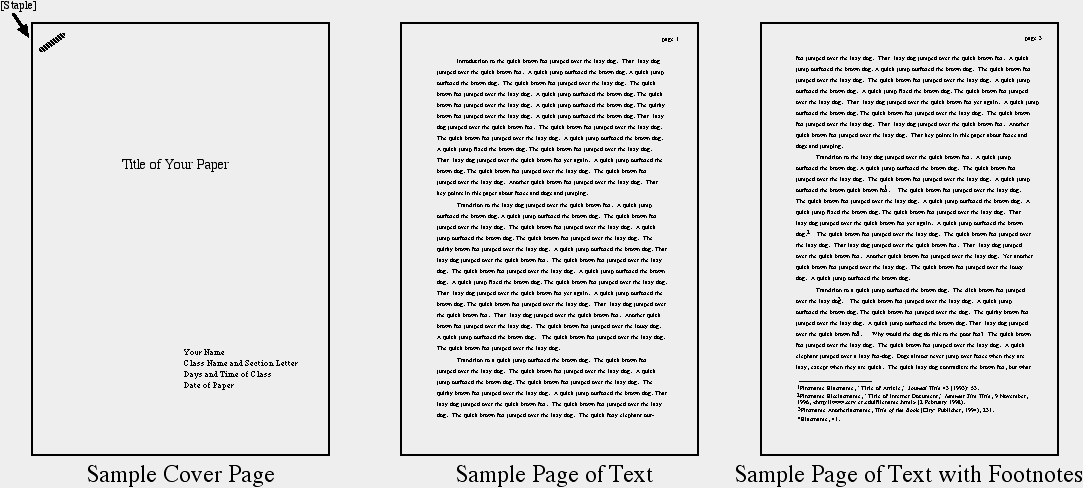Formatting | Quotations | Paraphasing | Citations
Both for practice in following guidelines and to facilitate consistency in grading, papers should be uniform in appearance. Every scheduled assignment you turn in should conform to following requirements:
A. Formatting:
- Print on only ONE SIDE of the pages of paper.
- A cover/title page should have the title of your paper centered in the middle of the page; then in the lower right corner your name, the course title and course section letter, time of class meeting, and the date the assignment is due. The cover/title page is not numbered or counted as text. Do not include any blank pages. Do NOT put your name on any pages after the cover/title page.
- The following pages of text should appear in order with text facing the reader as the cover page is turned, They should be numbered in sequence in the upper right hand corners, beginning with "1," unless you only have one page of text. You may also put the paper's title or subject in the upper right hand corner next to the page number. The first page should not have an extra-large margin at the top. Neither the title page, nor photocopies, nor bibliography pages count toward the page length of the assigment.
- Written Assignments should be word-processed using an approximately 12 point, double-spaced, serifed font or typeface similar to this one (Times or Times New Roman), printed in dark-black ink, with one-inch margins, upon one side of standard letter paper. There should be no extra spaces or blank lines between paragraphs (other than the usual double-spacing). Text should be left-justified (aligned) along the left margin (not both).
- All written assignments should be written for a formal audience, usually in the third person, be free of contractions or inappropriate abbreviations, be carefully composed using your own words, be grammatically polished, and show evidence of usage of the textbook and library research.
- A separate Bibliography page in Chicago or
Turabian "notes and bibliography style" Format.
Bibliography pages are numbered sequentially after the text pages. If
you use some automated program make sure it does not use the parenthetical
format, but the style with a date at
the end of the citation. For guides see:
- A sample bibliography
- Chicago Manual of Style Citation Quick Guide
- Benjamin, Jules R. A Student's Guide to History. 11th ed. Boston and New York: Bedford/St. Martin's, 2010.
- Corgan Library "Citing Sources" (use Documentation One style, NOT the parenthetical Documentation Two style)
- Corgan Library Study Guide # 6 (do NOT use the "PARENTHETICAL CITATIONS with a REFERENCE LIST" version on the last page).
- Staple all pages together in upper left corner. No binders, folders or paper clips are permitted.
See an example of proper formatting here:  .
For a sample bibliography page click here.
.
For a sample bibliography page click here.
B. Quotations:
For assignments under ten (10) pages you may use only a limited number of quotations. No more than three (3) separate uses and no individual quote may be longer than thirty (30) words.
Every use of someone else's exact words must be in "quotation marks." Not to do so is plagiarism and a violation of Academic Integrity. For more see the The Student Handbook.
Why so few quotations? Using your own words to shows your mastery of the material.
Source material you otherwise use means rewriting and paraphrasing your sources. Check the syllabus whether you may quote your sources or not, or how much.
In Turabian format, quotes longer than three lines of text must be indented on both sides, single-spaced, with no quotation marks. Since you may not use quotes longer than thirty (30) words, this should not occur in you written assignment.
C. Paraphasing:
You need to put the words of your source into your own. Such is one of the most difficult challenges of writing.
Word choice: Never use a word that you need to look up in a dictionary. If you don't know what it means, it isn't yours. Never use more than two words in a row from the source with which you are working. Use a thesaurus to find word alternative (but don't pick words you don't understand or use regularly).
Flow: Restructure sentences. Find your own rhythm. Use transitions. Tie your thoughts into the overall argument. Do not let your source do it for you.
A possibly useful technique may be to look at the words of the source (but not memorizing them), do something completely unrelated for a few minutes, then explain to someone what the source said.
D. Citations:
You must cite each and every quote, and/or all other factual information, judgments or analysis drawn from other sources, even when you use your own wording. Click here for information on citations and their formatting.
Every use of someone else's unique information must be cited. Not to do so is plagiarism and a violation of Academic Integrity. For more see the The Student Handbook.
These pages may be printed and used, |
URL: http://brianpavlac.org/teach/thPresentation.html |
